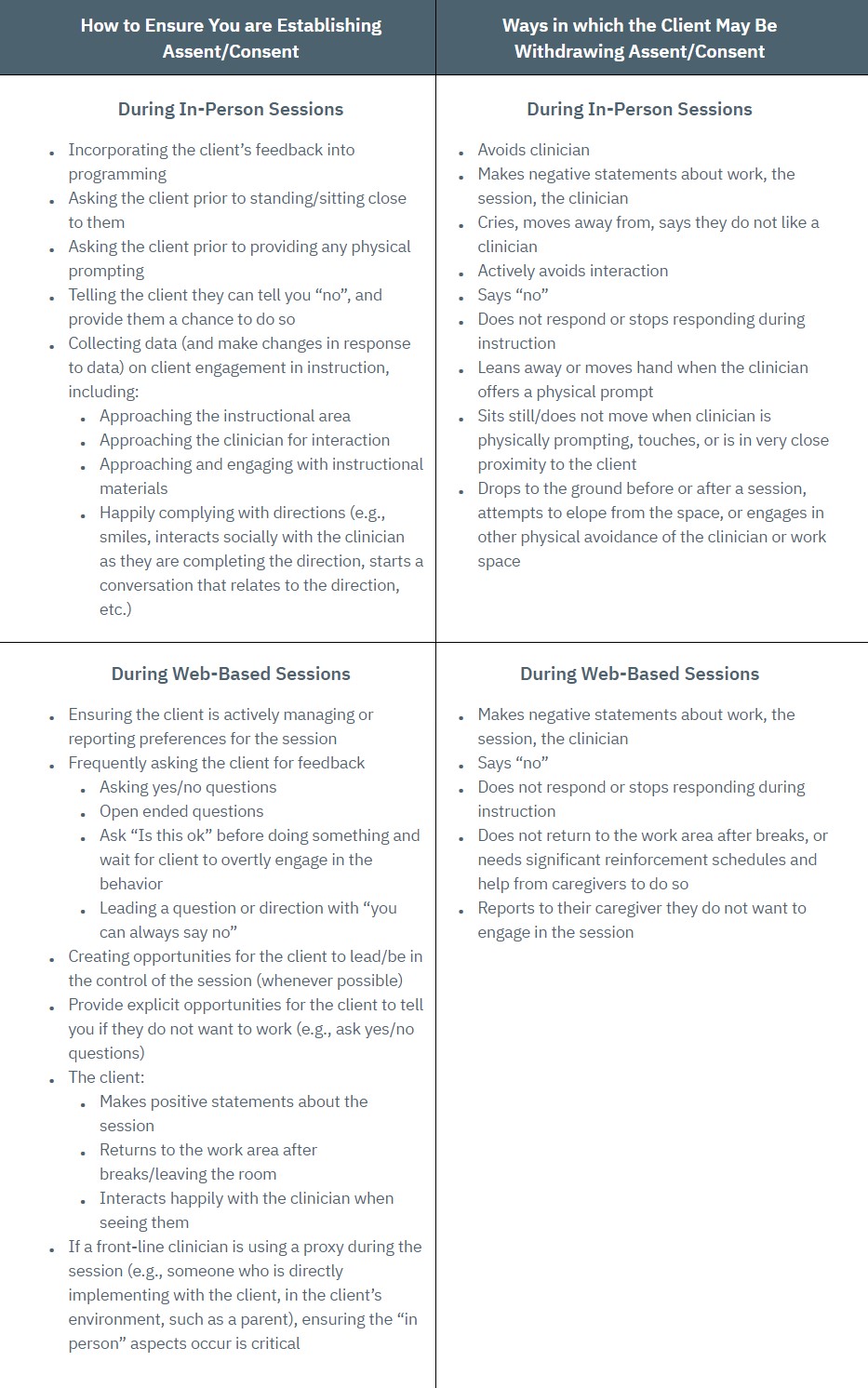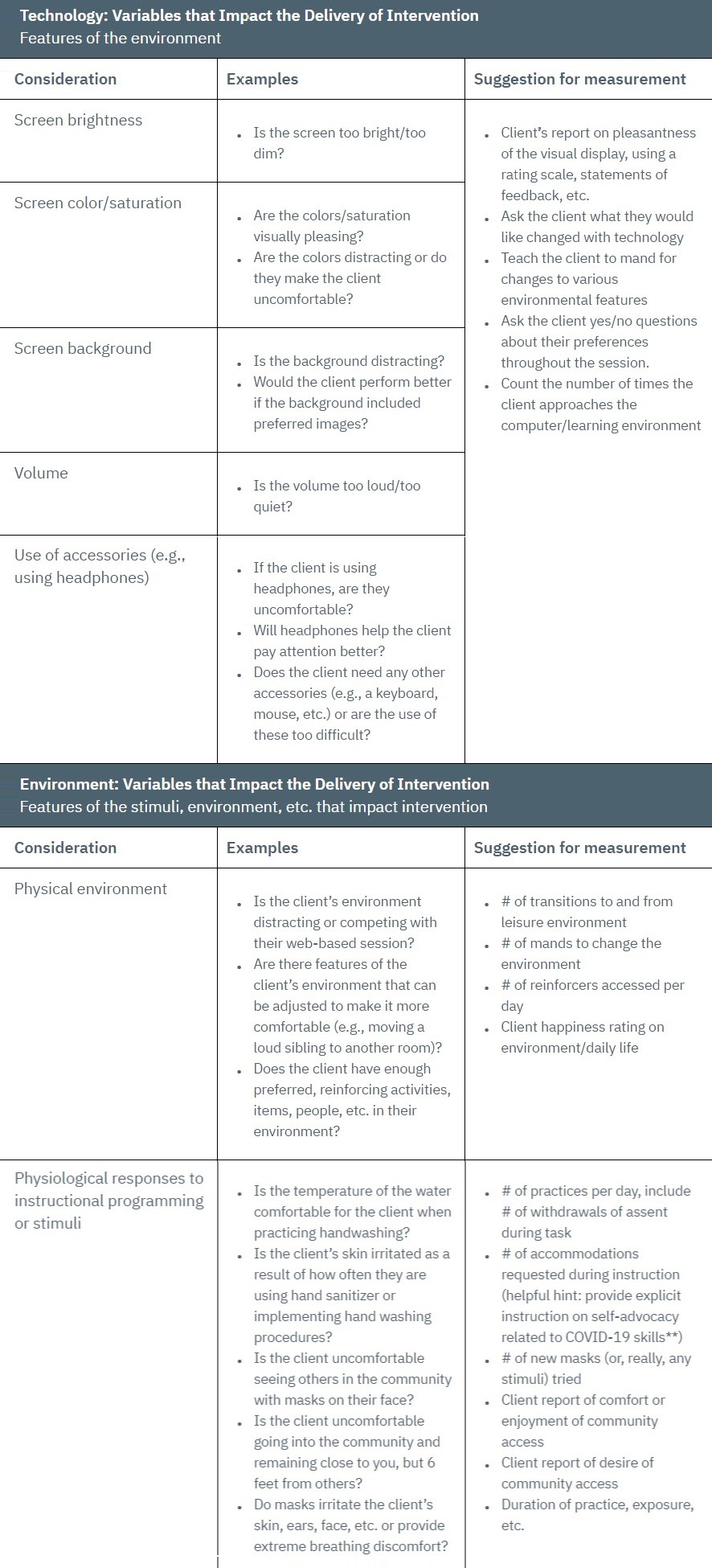Think back to the first time you participated in a web-based meeting. Were you nervous before speaking? Did you feel uncomfortable about whether or not people could see you or hear you? What if you used the restroom during the meeting - would the others notice? Would they laugh at you? When it comes to web-based learning and supervision, we all make mistakes, need to ask questions, and require some time to become comfortable. This is no different for clients with autism and their caregivers.
The rapid transition of behavioral service delivery from in-person to telehealth (as a result of COVID-19) creates many unique opportunities. On one hand, it supports the delivery of treatment to clients who would be unable to otherwise receive services (such as those who are socially distancing as a result of COVID-19, have restrictions based on geographic location, or are seeking services from a specific provider who is not based in their region). On the other hand, it creates unique hurdles for clinicians - especially the design and implementation of some of the most foundational elements of intervention programming. We are going to focus on and offer recommendations for two critical components of intervention via telehealth: (1) obtaining and maintaining client assent, and (2) establishing effective instructional support (i.e., instructional control).
Telehealth Service Delivery
There are two primary forms of telehealth service delivery utilized for focused or comprehensive behavioral services:
1. Consultation Model: Behavior analysts provide consultation to families and front-line clinicians (i.e., behavior technicians) via technology, while front-line staff delivers services in-person with clients. This arrangement takes many forms, but often involves a combination of web-based meetings, off-site reviews of the client’s data, and consistent review of client video (California Association of Behavior Analysis, n.d.).
2. Direct Service Delivery Model: Front-line staff (i.e., behavior technicians) deliver direct services to clients via web-based meetings. This arrangement may include the use of a parent, caregiver, sibling, or another family member as a proxy, to support the implementation of the intervention (California Association of Behavior Analysis, n.d.).
Both of these service delivery models require the behavior analyst to thoughtfully design intervention, and to include measures of client consent, reliability of implementation, and social validity (as they do/should when providing in-person supervision or intervention). When implementing direct-service delivery models via telehealth, it may be difficult to establish and ensure consent and instructional support. This is because clinicians need to change their familiar modes of rapport, reinforcement, and accommodations. When utilizing a telehealth consultation model to provide remote supervision, behavior analysts must adjust their measures of client assent and participation in intervention, as well as their direct supervision of sessions (i.e., review of session video, or “call-ins” to sessions). They must ensure they are observing the ways in which front-line staff are confirming assent and demonstrating effective instructional support, while also maintaining social and safety rules.
Establishing and Maintaining Consent
Behavior analysts often talk about consent as it relates to parents or guardians providing consent to treatment at the onset of behavioral services, or consent to add or modify treatment goals or behavior support plans (BACB, 2014). Consent, however, refers to the “compliance in or approval of what is done or proposed by another” (Merriam Webster, n.d.). Assent is consent given by the client, when the client is under the age of 18 (University of Alaska Fairbanks, n.d.). Consent/assent must be given by the client during each and every minute you are providing direct services and must occur free of any coercive contingencies. Consent/assent for treatment (or, really, engagement in anything) from people with autism and other developmental disabilities is often overlooked and undervalued when compared to neurotypical individuals.
Consider, for a minute, a situation at a tutoring center in which a neurotypical learner says (or shows) overtly that they are uncomfortable with a work task, situation, proximity to another, or they ask to stop an activity. This request would be honored, accommodations would be offered, help provided, etc. It is unlikely that the tutor would move to a more intrusive physical prompt, sit closer, or not stop the task. Though the tutor of a neurotypical student may tell the student’s parents that the student was not cooperative (or some other negative report of their withdrawal of assent) it is highly unlikely that the tutor would continue without changing their approach, or that they would increase their intensity of instruction. In fact, a parent would likely be horrified if their child said, “I’m uncomfortable, I don’t want to do this math problem,” and a tutor then proceeded to provide a hand-over-hand prompt to complete the problem.
The consent/assent of people with autism and other disabilities must be treated in this exact same way. If the client does not consent to work, work should not happen (Bannerman et al., 1990).
Often, clinicians wonder if they are reinforcing work-avoidance behavior when reinforcing and promoting client assent, and not only allowing clients to withdraw assent, but specifically teaching clients to withdraw assent. The short answer is, YES! Remember - your client is a human being, and it is their right, as a human being, to tell you, “No, I do not want to do this,” or “I do not want to do it this way,” or to “seriously, just stop what you are doing.” The client should never be forced to work with you. It is your job, as a clinician, to arrange instruction to both promote and maximize client engagement (Bannerman et al., 1990).
Evaluating Consent
Now that we established the importance of consent/assent, how can you evaluate whether or not you have it? Assent, or the withdrawal of assent, can take many forms and should be operationally defined at the onset of treatment (and throughout treatment) for each client. Measures of assent should be included in every client’s program, regardless of the form of intervention (Bannerman et al., 1990; Reed, 2014). When delivering telehealth services, it is important for front-line clinicians to identify whether or not they have assent/consent when delivering services via web meetings. When providing supervision via telehealth to sessions that are occurring in-person, it is important to keep your eye on specific features of intervention (particularly when working on health, hygiene, and social skills that are COVID-19-specific). Below is a table outlining examples of possible ways to ensure you are offering clients an opportunity to demonstrate consent, in both direct-service and web-based intervention arrangements.

Instructional Support in the Context of Telehealth
After establishing assent/consent, it is important to establish and maintain a productive therapeutic relationship of instructional support, often referred to as “instructional control.” We refer to this productive relationship as instruction support, as this implies we are supporting a person (not controlling them), while the term “instructional control” is a statement that we are exerting control over a person. Establishing and maintaining this support results in the client (1) effectively engaging in instruction, and (2) participating happily and free of coercion throughout the session (Bannerman et al., 1990).
As stated earlier, delivering direct services via web meetings (telehealth) can pose some unique obstacles to client engagement. There are many things you can do both prior, as well as within intervention sessions, to maximize client comfort, happiness, and the likelihood of responding. Often our clients experience sensory sensitivities. These can and should be planned for (prior to intervention) and accommodated (within intervention). Let’s begin by looking at some examples of environmental variables you can modify, to potentially maximize client engagement and accommodate for client’s sensory needs:

** For example: advocate to take a breathing break while wearing a mask, mand to use sanitizer versus wash hands, mand to try without physical support, etc.
Summary
The ultimate goal of behavior analytic intervention is to improve the quality of life of our clients, as well as to produce socially valid changes in skills in our clients and their caregivers. It is critical to remember - this is not an “end goal.” Quality of life, social validity, and overall happiness are elements of a program that must be strategically planned for, implemented, and evaluated on an ongoing basis - from the very first moment intervention is initiated (Bannerman et al., 1990; Breaux, n.d.; Smith & Milyko, 2020).
Ensure the data you collect are informing your decision making! Do this by reviewing client consent and happiness data FIRST - this way, every skill you look at will be framed with these data (i.e., Jordan may be doing a great job on his labeling program, but he made 27 negative statements about the session and withdrew assent 10 times throughout the session, so something needs to change).
As telehealth services are newer to the field of behavior analysis, you will need to think outside of the box as you develop measures of consent and instructional support. We included some beginning measures that may be helpful for you clients, but these measures should be adapted and other new measures created for your specific client.
About the Author

Kristin Smith, M.Ed., BCBA, LBA
CentralReach, Instructional Designer
Kristin Smith, M.Ed., BCBA, LBA is a Licensed Behavior Analyst, and Board Certified Behavior Analyst. She began her career in the field of behavior analysis in 2002 and received a master’s degree in Special Education from the University of Washington. Kristin has experience implementing and designing intervention programs across a variety of contexts, with learners ranging in age from 18 months to 40 years. She works with a wide variety of learners, including, but not limited to those with autism, chromosomal deletions, cognitive impairments, learning disabilities, social-emotional and/or behavioral problems, significant challenging behavior, blindness, and children with multiple disabilities. Her areas of expertise include Precision Teaching, instructional design, assessment, and data analysis.
References
Bailey & Burch, 2011. Ethics for behavior analysts (2nd expanded ed.). New York, NY: Routledge.
Bannerman, D.J., Sheldon, J.B., Sherman, J.A., & Harchik, A.E. (1990). Balancing the rights to habilitation with the right to personal liberties: The rights of people with developmental disabilities to eat too many doughnuts and take a nap. Journal of Applied Behavior Analysis, 23, 79-89.
Behavior Analyst Certification Board (2014). Professional and ethical compliance code for behavior analysts. Retrieved from https://www.bacb.com/wp-content/uploads/BACB-Compliance-Code-english_190318.pdf
Breaux, C. (n.d.). Client dignity in practice: best practices for trauma-free ABA. [Video]. Central Reach.
https://centralreach.com/institute
Lotan, G. & Ells, C. (2010). Adults with intellectual and developmental disabilities and participation in decision making: Ethical considerations for professional-client practice. Intellectual and Developmental Disabilities, 48(2), 112-125.
Merriam Webster. (n.d.) Definition of consent. Retrieved June 15, 2020
https://www.merriam-webster.com/dictionary/consent#:~:text=%3A%20permission%20for%20something%20to%20happen,consent
Reed, D.D. (2014). On the shoulders of giants: Kansas City Autism Training Center. Behavior Analysis in Practice, 7, 33-35.
Smith, K., & Milyko, K. (2020, June 24). Skills for social distancing, health, and home: ABA programming for the new world [Webinar]. CentralReach. https://centralreach.com/institute
Telehealth and the practice of applied behavior analysis (ABA). (n.d.). California Association of Behavior Analysis. Retrieved July 10, 2020 from https://calaba.org/media/content/CalABA_TeleHealth_Practice_Brief_Final-2.pdf
University of Alaska Fairbanks. (n.d.). Institutional review board: Consent and assent.
https://www.uaf.edu/irb/faqs/consent-and-assent
Van Houten, R., Axelrod, S., Bailey, J.S., Favell, J.E., Foxx, R.M., Iwata, B.A., & Lovaas, O.I. (1988). The right to effective behaviour treatment. Journal of Applied Behavior Analysis, 21, 381-384.